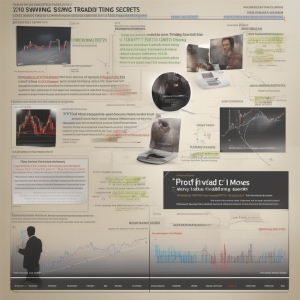Table of Contents:
Introduction: Understanding Swing Trading Strategies
Swing trading strategies have become a popular method for grasping profit in the ever-fluctuating waves of the market. Perfect for those who can't monitor the market 24/7, swing trading captures profit from short-to-medium term price movements, commonly within a span of days to weeks. The purpose of this introduction is not only to provide you with a fundamental understanding of swing trading strategies but also to offer useful tips on how to enhance your own trading success.
This comprehensive guide will cover common swing trading tactics, explain how to spot advantageous conditions, and ultimately enable you to seize the profit potential of volatile market moves. It aims to equip both novice investors and seasoned traders with practical insights into the world of swing trading.
If you've ever found yourself overwhelmed by day trading or puzzled by long-term buy-and-hold strategies, swing trading could be the ideal compromise. Let's dive in and uncover the secrets of swing trading!
Swing Trading Vs. Other Investment Strategies
Before delving deeper into swing trading strategies, it's important to compare it to other investment approaches. This section will provide a brief overview of how swing trading squares up against other popular investment strategies such as day trading and long-term investing.
On one hand, day trading is characterized by frequent in-and-out trades within a single day. Day traders live by the mantra, "The market giveth and the market taketh away - all in a day's work." On the other hand, long-term investing focuses on holding securities for months or even years, with an unwavering belief in their potential growth or consistent dividends.
Swing trading finds its niche somewhat in between these two strategies. It combines the possibility of quick profits like in day trading with the patience and long-term vision of stable investing. Indeed, with swing trading strategies, traders can capitalize on both rising and falling markets, making it a versatile alternative for a diversified investment portfolio.
The following sections will delve further into the details and nuances of swing trading strategies.
Pros and Cons of Swing Trading Strategies
| Advantages | Disadvantages |
|---|---|
| Potential for significant profits in a short time. | Requires considerable knowledge and experience to conduct effectively. |
| Doesn't require constant attention to market trends. | Risks of major financial losses. |
| Suitable for individuals who can't monitor the market all day. | Can lead to stress in volatile market conditions. |
| Allows for strategic planning to maximize gains | Not suitable for beginners without guidance. |
The Core Principles of Swing Trading

Swing trading is founded on a few essential principles that differentiate it from other trading strategies. The core concepts of swing trading revolve around recognizing and capitalizing on price trends and patterns. Rather than aiming for one massive profit, swing traders typically seek smaller gains that can accumulate over time. Here, we'll take you through the principal aspects of this trading practice.
Trend Identification: A key factor is the ability to identify 'swings' in marketplace prices. These swings refer to the alternating high and low price points that occur on charts. Trends can be upward, downward or sideways. Established swing trading strategies capitalize on these cyclical price movements.
Technical Analysis: Swing traders typically focus on technical analysis more than anything else. They use various charts and patterns to predict future price actions. Tools such as moving averages, support and resistance levels, and price momentum are commonly used to make informed trading decisions.
Timing: The timing of entry and exit is crucial in swing trading. Traders must determine the optimum time to enter a trade at the start of a price swing and exit at its peak before it reverses. This requires a keen understanding of market indicators and sentiment.
Risk Management: Like any trading strategy, swing trading involves risk. However, the focus here is on managing risk effectively. Swing traders typically set tight stop-loss orders to limit potential losses.
In the following sections, we will explore these principles in more detail and how you can leverage them in your own swing trading strategies.
Simple Steps to Kickstart Your Swing Trading Journey
Venturing into swing trading doesn't have to be daunting. Below are some fundamental steps to kickstart your journey into this exciting trading strategy:
1. Choose Your Playground: Select the market you'd like to swing trade within. This could be stocks, forex, commodities, indices, or cryptocurrencies. Each one comes with its own set of rules, volatility levels, and opportunities.
2. Learn the Technicals: As mentioned before, technical analysis is vital in swing trading. Brush up on areas such as chart patterns, trend lines, resistance and support levels, relative strength index (RSI), moving averages, and Fibonacci retracements to help you make informed decisions.
3. Set Up Your Trading Plan: Develop a clear plan that specifies your entry and exit points, the amount you're willing to invest, your stop loss and your take profit levels. A well-structured plan helps manage your emotions during the trading process.
4. Test Your Strategies: Before rushing into the market, try out your swing trading strategies on a demo account. By doing so, you can refine your methods and gauge their performance without risking any real money.
5. Keep Up With The Market: Stay updated with market news, as economic events can create sudden swings and opportunities. Using an economic calendar can help you anticipate these movements and adapt your strategy accordingly.
6. Continually Monitor and Adjust: The market is ever-changing, and so should your strategies. Regularly review your trading results, learn from any mistakes, and make the necessary adjustments to enhance your future trades.
Remember, success in swing trading comes from patience, discipline, and continuous learning.
Key Tools for a Successful Swing Trading

Tools are essential in implementing effective swing trading strategies, helping traders to understand market trends, identify swings, manage risks, and predict future price movements. Here are some critical tools to consider:
Market Charts: Charts are a trader's best friend, providing visual representation of price movements over a given period. Types of charts include line charts, bar charts, and candlestick charts, the latter being the most preferred due to the amount of information it offers about price distribution during a particular timeframe.
Technical Indicators: These indicators offer quantitative information about market trends and patterns, assisting traders in making more informed decisions. Among the most utilised are moving averages (MA), relative strength index (RSI), moving average convergence divergence (MACD), and Bollinger Bands.
Trading Software: Today's trading is highly digital. Various online platforms provide features like real-time market data, charting tools, technical indicators, news feeds, and even AI-driven algorithms for trade execution. These platforms can be a valuable resource for executing your swing trades more efficiently.
Risk Management Tools: Tools like stop-loss orders and take-profit orders play an integral role in managing risk effectively. Stop-loss orders automatically close a trade when the price reaches a certain level, thus limiting potential losses, while take-profit orders lock in profits once a certain price level is reached.
Each of these tools plays a distinctive role in successful swing trading. Their skilful and timely application can lead to improved trading performance. But remember, no tool can guarantee profits. Trading requires judgement, patience, and above all, continuous learning.
Popular Swing Trading Techniques
Now that we've covered the basics, let's explore some popular swing trading techniques that traders utilize to profit from market swings. Remember, each strategy carries its unique benefits and risks, so choose a technique that resonates with your risk tolerance, investment objectives, and temperament.
1. Breakout Trading: This strategy involves identifying and entering a trade when the price of a security breaks above resistance or below support. A break above resistance signifies a bullish trend, signaling a good time to buy. Conversely, a break below support indicates a bearish trend, prompting a sale.
2. Retracement Trading: Retracements are temporary price reversals in an overall trend. Retracement trading takes advantage of these small pullbacks within a larger trend. The trader identifies a trend, waits for a pullback, and then enters the trade in the direction of the initial trend.
3. Reversal Trading: This strategy relies on identifying the peak point at which a trend starts to reverse. Once the trend reversal is confirmed, traders will enter the market with a position opposite to the former trend.
4. Pullback Trading: Pullbacks occur when the market eases off briefly after a substantial move. Swing traders capitalize on these opportunities by entering the market after a pullback once indications show that the trend is likely to continue.
Mastering these techniques can take time and experience, but they form the foundation of successful swing trading strategies. Always remember to test and adapt your strategies in line with market changes and your evolving investment goals.
Mitigating Risks in Swing Trading

Even with the excitement and potential profits of swing trading strategies, it's crucial not to forget the risk management. Sound risk management protocols can mean the difference between a profitable trade and a severe loss. Here are some steps to mitigate risks in swing trading:
Set a Stop-Loss Order: Probably one of the most effective risk management tools, a stop-loss order is a predetermined point at which you sell a security to avoid further losses. It helps limit the potential financial damage of a bad trade.
Know Your Risk Tolerance: Before starting a trade, calculate the amount of risk you can comfortably take, commonly referred to as risk capital. This would typically be a sum of money you are ready to lose without it affecting your financial health markedly. Always trade within these limits.
Use Only Risk Capital: As alluded above, always trade with funds that you can afford to lose without grave consequences. If a trade puts your financial well-being on the line, it's better to postpone it until you've accumulated an adequate risk capital.
Manage Your Trade Size: Don't put all your eggs in one basket. By diversifying your investments and limiting your trade size, you minimize the risk associated with potential loss in any singular trade. A common guideline is not to risk more than 1-2% of your account balance on any single trade.
Always Have an Exit Strategy: Besides having a stop-loss order, knowing when to exit a winning trade is also vital. Not all trades will go according to plan, and it's essential to know when to cut your losses or take your profits and exit.
By incorporating these risk mitigation strategies, you can protect your capital while enjoying the swings of the market, positioning you for sustained success in the exciting world of swing trading.
Conclusion: Recap of Profiting through Swing Trading
In conclusion, swing trading provides a compelling middle ground between the buzzing world of day trading and the patience-testing pace of long-term investing. This balanced strategy offers opportunities to profit both from short-term price swings and longer-term trends. Its flexibility and potential returns make it an appealing approach for beginners and seasoned traders alike.
Through clear understanding and application of swing trading principles such as trend identification, technical analysis, and solid entry-exit strategies, one can be well-poised to capture profits effectively. Moreover, proper risk management and diligent market watch will prove valuable in practicing these swing trading strategies.
In this volatile yet promising crypto universe, capturing profits from market swings seems less intimidating and more approachable, thanks to swing trading. As with all financial strategies, continuous learning and keeping abreast of market happenings are key to succeeding in swing trading. So embark on this investment journey equipped with these insights, and witness the secret powers of swing trading unfold.
Be sure to stay tuned for more articles on our Capitalizing Crypto series, where we expose the secrets of profiting in the cryptocurrency market using varied strategies. Next time, we will delve deeper into the world of day trading and its potential course to crypto riches. Until then, happy trading!
Frequently Asked Questions about Swing Trading Secrets
What is swing trading?
Swing trading is a type of trading strategy where a trader holds an investment, typically stocks or options, for a period of several days to several weeks to profit from possible price changes or 'swings'.
What are the benefits of swing trading?
Swing trading allows for flexible time management, potential significant percentage returns, and risk management due to the short-duration positions, among others.
Can beginners do swing trading?
Yes, with proper education and practice, beginners can do swing trading. However, it's advised to start with a simulation before risking real money to understand the principles and potential risks.
What should I look for in a swing trading setup?
Important things to consider are the trend direction, volume analysis, significant stock levels, and market sentiment. Additionally, well-structured risk management is key.
How can I capture profits in market moves with swing trading?
Capturing profits involves buying at a lower price point and selling at a higher price point within a swing. This can be accomplished by identifying potential upward or downward swings in the market.












